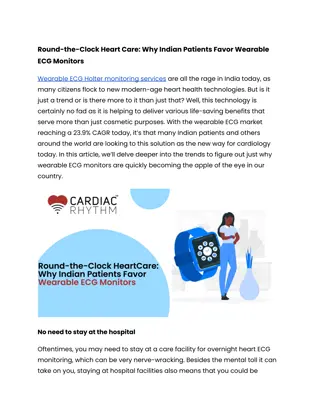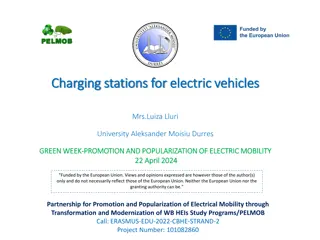Philipp Gutruf IP Portfolio - Wearable Implantables and Wireless Charging
Senphonics Wearable and Implantables portfolio showcasing Bone Sensor, Wireless Charging, Personalized Fit Platforms, Behavioral Driven Design, Subdermal Implantable Transcranial devices, and more. Explore the future of technology and innovation in healthcare.
Download Presentation

Please find below an Image/Link to download the presentation.
The content on the website is provided AS IS for your information and personal use only. It may not be sold, licensed, or shared on other websites without obtaining consent from the author.If you encounter any issues during the download, it is possible that the publisher has removed the file from their server.
You are allowed to download the files provided on this website for personal or commercial use, subject to the condition that they are used lawfully. All files are the property of their respective owners.
The content on the website is provided AS IS for your information and personal use only. It may not be sold, licensed, or shared on other websites without obtaining consent from the author.
E N D
Presentation Transcript
Philipp Gutruf IP portfolio
Senphonics Wearable general Implantables Bone Not mandatory Implantables Opto UA19-123 Wireless Charging and Communications UA19-123 Wireless Charging and Communications UA19-123 Wireless Charging and Communications UA19-123 Wireless Charging and Communications Not mandatory Not mandatory Not mandatory UA21-106&7 UA21-106&7 UA21-106&7 23-044 Behaviorally Driven Electromagnetic Design Personalized fit platform Personalized fit platform Personalized fit platform Not mandatory 23-044 Behaviorally Driven Electromagnetic Design UA22-265 UA21-106&7 UA22-265 Subdermal Implantable Transcranial Personalized fit platform Lora Not mandatory Not mandatory UA22-057 3D Mesh Electrodes UA19-091 Implantable Bone Sensor 23-044 Behaviorally Driven Electromagnetic Design 23-044 Behaviorally Driven Electromagnetic Design Not mandatory UA22-265 UA 22-173 Implant powering UA 22-173 Implant powering Lora
Bone Sensor - UA19-123 Wireless Charging and Communications UA19-091 Implantable Bone Sensor
Subdermal Implantable Transcranial UA22-173 Wearable Power for Battery Free Implants UA21-106&7 Personalized fit platform UA19-123 Charging & Comms UA22-265 UA22-057 3D Mesh Electrodes Subdermal Implantable Transcranial
What must go together? What can be separated? UA21-106&7 UA22-173 Wearable Power for Battery Free Implants Personalized fit platform UA19-123 UA22-057 3D Mesh Electrodes Charging & Comms UA23-044 Behavior Driven Design
IP Status Tech ID Title PI Status Wireless Battery Free Long Range Wearable Recording Platform for Digital Acquisition of Chronic Biological Signals 19-123 Philipp Gutruf US National Stage 20-232 3D Printed, Stretchable Epifluidic Platform Philipp Gutruf No IP filed; 21-106 and 21-1073D-Printed, Personalized Wearable Electronics Shaped by 3D Datasets; 3D Printed Epifluidics Philipp Gutruf PCT Filed 22-057 3D Printed Electrodes for Electrophysiology Recordings Philipp Gutruf need to file Wearable Wireless Power Supply and Data Communication Device for Small Battery Free Implant Wireless, Wearable NFC Enabled Power and Communication for Chronic Interfacing with Battery-Free Implants 22-173 Philipp Gutruf Need to file 22-250 Philipp Gutruf Wireless, Battery-Free, Subdermal Implantable Platforms for Transcranial and Long-Range Optogenetics nothing filed; provisional needs to be filed 22-265 Philipp Gutruf Biosymbiotic Device for Wearable, Long-Range Transmission of High-Fidelity Biosignals nothing filed; provisional needs to be filed 22-302 Philipp Gutruf 23-044 Behaviorally Driven Electromagnetic Design Philipp Gutruf Provisional Filed
UA19-091 An Implantable Miniaturized and Soft Wireless Sensor to Monitor Tissue and Bone Deformation This invention consists of an inexpensive implant to adhere to the bone. This device is capable of sensing bone strain, reporting loads passing through bone for extended periods of time. The implant can be used to monitor bone growth for bone segment repair for long bones or to monitor changes in bone characteristics of patients with osteoporosis. This technology has the potential to give physicians the ability to predict when a patient with osteoporosis has an impending fracture, and thus the ability to intervene and prevent further damage. Background: Osteoporosis, also known as a silence disease goes undetected and undiagnosed in more than 50% of cases. Due to its asymptomatic nature, osteoporosis is rarely detected in its earlier stage (Osteopenia) unless patients subject themselves to preventive screening, only until a fracture occurs will osteoporosis be diagnosed and begin to be treated. Though different tests such as Bone Mineral Density Testing provides an effective diagnostic of osteoporosis, monitoring of bone progress, deformation, or healing thereof, is largely unattended. The biggest task or need in the diagnosis and treatment of osteoporosis is in improving screening methods and monitoring bone deformation as the disease progresses. Applications: Osteoporosis treatment Osteoporosis diagnostics Orthopedic screening & imaging Advantages: Miniature size promotes more precise readings and measurements of bone activity Cost effective: production of chip is inexpensive
UA19-123 Wireless Battery Free Long Range Wearable Recording Platform for Digital Acquisition of Chronic Biological Signals This invention is a stretchable and intimately coupled battery-free system for infinite chronic recording of bio-signals at a distance, enabling steady streams of clinical grade information for use in digital medicine. Background: Remote monitoring using smart biosensors can decrease patients referral to health centers up to 30%. This saves time and money for the patient and health centers. Current wearable biosensors require frequently manual recharge and need to be removed for some daily activities resulting in increasingly low user compliance and on average only 5 months of device usage before rejection. This device technology offers continuously collected data without the need for user interactions for uninterrupted clinical grade data streams for months. Applications: Digital medicine Human machine interface Gaming systems Simulation technologies Advantages: Wireless recharge at distance (0.5-1.5m) Long range data collection Clinical grade biosensors Bluetooth data transmission Uninterrupted wearability (no adhesive month of wear)
UA20-043 A New Device to Treat Pulmonary Arterial Hypertension (PAH) Through Neuromodulation This invention is a method of treating pulmonary arterial hypertension without the use of drugs. The invention describes a system for bilateral electrical stimulation of the vagus nerve that can be implanted in the human body with the goal of ameliorating symptoms of pulmonary arterial hypertension. This device can be used with neonatal populations, where there have been limited therapies approved. Background: Pulmonary hypertension is a group of diseases characterized by elevated blood pressure in the lungs. There are five types defined by the World Health Organization, each based on the root cause of the elevated blood pressure. All types of pulmonary hypertension are serious, and if untreated, can lead to right heart failure and even death-- group 3 pulmonary hypertension has a 1-year mortality of 46%, followed by group 2 at 40.9%. Among neonatal patients, there are limited therapies and drugs that have been approved for the treatment of PAH. Currently nitric oxide is an existing treatment, but it is not widely used. Pulmonary hypertension is currently not curable, but its symptoms can sometimes be managed. Partly thanks to its orphan status, a number drugs have been recently developed to treat group 1 pulmonary hypertension directly, but other types are often approached in terms of treating the underlying disease or even surgically. There is a clear need for more and better therapies for pulmonary hypertension, given that the current drugs are expensive, can have unpleasant side effects, and cannot be applied to all groups of pulmonary hypertension. This invention has the potential to fill that gap, and provide a way of treating all groups of pulmonary hypertension with few to no side effects. Applications: Nonpharmacological treatment of pulmonary hypertension Advantages: Targeted to neonatal population, where limited therapies exist Stimulation results in few to no side effects Technique can be applied to all groups of pulmonary hypertension unlike current pharmacological interventions The invention may also be more cost-effective than current drugs Once implanted, patient will rarely need to return to the point of care whereas some drugs require repeated or constant infusions
UA20-232 3D Printed, Stretchable Epifluidic Platform This technology is a 3D printed device that can be mounted on the skin and collects small amounts of sweat to measure its contents. The 3D printing technology enables the device to be custom manufactured to conform to an individual s body and to be mounted without applying adhesives to the skin. Background: Epifluidics is a rapidly evolving area of microfluidics, where devices are applied to the surface of the skin, typically to collect tiny amounts of sweat for analysis. The sweat can then be analyzed within the device to look for particular markers. Research suggests this type of technology can be used to non-invasively detect many health-related metrics, including hydration levels, blood sugar levels, and blood alcohol levels. As an emerging area of innovation, there are few commercial applications of epifludics available. Furthermore, current technologies are generally limited in that they can be bulky and rigid, and they require the use of adhesive to keep them attached to the body. As a result, current epifluidic technologies are generally not conducive to long-term use. This technology solves these limitations by leveraging 3D printing to create a soft, flexible device custom-manufactured to conform to an individual s body, which in turn eliminates the need for adhesives to keep it in place and enables it to be worn comfortably for longer periods of time. Applications: Fitness monitoring / athletic training Chronic health condition monitoring Skin health analysis Advantages: Ideal for extended use Does not require use of adhesive Individually customizable to conform to the body Made of flexible material; stretchable
UA21-107 3D Printed Epifluidics Sweat-based biomarkers provide new, noninvasive means of acquiring and monitoring biological signals that were previously only accessible through invasive or costly lab-based measurements. Monitoring biodata such as sweat rate and sweat-based electrolyte concentration enable insight into health statuses such as hydration. Monitoring other metabolites, such as sweat glucose, lactate and pH enable at home diagnostic capabilities that can screen high risk patient populations. Current technologies for implementing these sensing structures rely heavily on time intensive tests executed by trained staff. Recent advances in fluid handling on the skin by utilization of microfluidics devices attached to the skin, called epifluidics, enable much improved fluid handling and analysis directly on the skin. The fabrication processes, however, are difficult to translate and do not enable rapid prototyping and broad dissemination, a barrier to commercialization of these class of devices. Additionally, epifliudic platforms face many challenges towards daily application outside of controlled environments, particularly for long periods of application, as they rely heavily on the use of temporary adhesive backings and rigid materials that do not allow for flexible and conformal mechanical properties, impeding daily activity. Creating epifluidics using 3D printing of elastomeric materials provides a low-cost and easily manufacturable method for producing these devices with accurate control over channel design and integration with electrical components, enabling continuous, quantitative detection of biomarkers not possible with current technology and with the use of adhesives, extending the functional lifetime and wearability of the system. FDM printing of these systems allow for flexibility in design with the ability to rapidly produce and manufacture these devices at a low cost and minimal capital investment. The impact of this technology enables broad dissemination of epifludic devices that are used in continuous applications. Background: Epifluidics is a growing industry in medical monitoring and eccrine sweat is currently used and researched to understand more about medical conditions in the human body. The disclosed technology uses 3D printing to form the 3D channels that collect sweat from the user and detect properties within the sweat. Furthermore, the 3D printing allows for integration with electronics and therefore automated, continuous biodata from the sweat. This technology can also be employed in conjunction with the 3D scanning and customizable electronic mesh technology developed by the same inventors to provide personalized wearable devices with a perfect fit to provide consistently accurate data for diagnostic, therapeutic and screening applications. Applications: Medical studies Chronic condition monitoring Daily health monitoring Advantages: Low cost Customizable Accessible
UA21-106 3D-Printed, Personalized Wearable Electronics Shaped by 3D Datasets Proliferation and miniaturization of technology, particularly electronics, enables medical device technology in wearable format with multimodal biometric sensors, ranging from fitness wearable to advanced monitors for chronic diseases. Many of these devices suffer from poor data quality and user compliance issues due to generic strap on device designs that do not conform to the user s unique physiology. 3D printing provides the ability to design and manufacture medical devices that are directly tailored to the patient and therefore enables optimized placement for sensors and intimate contact to the target improving sensing fidelity and user comfort. Topological information derived from 3D generated models acquired using conventional imaging techniques such as photogrammetry using smartphones and existing 3D data of subjects such as MRI or CT medical imaging enable mm accurate generation of wearable device meshes, previously introduced by the inventors, unique to the subject. These designs can then be rapidly prototyped or manufactured using 3D printing to fit the individual needs for multimodal data acquisition and the need of the user. This personalization enables more accurate and chronic diagnostic, therapeutic and screening applications. Background: Chronic conditions affect approximately 133 million Americans, ca. 40% of the population, according to the National Health Council. Chronic monitoring enables personalized treatments that significantly improve treatment outcomes. Multimodality of these monitors with capabilities such as blood pressure, glucose levels, blood oxygenation etc. provides a rich dataset that can be analyzed with modern signal processing methods. Current shortcomings of wearable devices however are the fidelity of measurements which lacks behind bulky gold standards prohibiting the use in diagnostics and therapeutics. Therefore, there is a clear need for high fidelity devices that are imperceptible for the wearer to enable long term chronic measurements. This technology allows for a 3D printed, customizable wearable technology that ensures a perfect personalized fit for any user thereby increasing the fidelity and ensuring consistent accuracy of the collected data. Furthermore, the device does not require any adhesive, reducing irritation and enable chronic measurements. Applications: Biodata monitoring Personalized device development Advantages: Adaptable Affordable Customizable High fidelity contact generation Improved sensor performance Increased user comfort Increased user compliance
UA22-057 3D Printed Electrodes for Electrophysiology Recordings This technology is a new way to support electrodes for medical analysis. The normal electrode attachment method is to use a body- safe adhesive to place the electrode on the skin. This device presents another way to support the electrode: by using a mesh (like a piece of clothing) to physically hold the electrode in space over the body. This mesh is a series of 3D printed pieces and are woven together to create a mesh device. Background: Electrodes play a large role in sensing abnormalities throughout different parts of the body. Current electrode attachment methods involve using adhesives to attach them to the skin. However, this is not a long-term solution as the adhesive has a lifespan. This technology design of the electrodes allows for natural processes, such as sweating and epidermal turnover, to take place without frustration of the sensing interface and degradation of the adhesive attachment. These features enable continuous operation which is well above the current limit with wet electrodes. Applications: Medical electrophysiology Athletic research At home patient monitoring Advantages: Continuous operation Allows for natural skin processes to take place
UA22-250 Wireless, Wearable NFC Enabled Power and Communication for Chronic Interfacing with Battery-Free Implants This device will allow for long-term, secure, and reliable data collection from implantable biosensors in a simplified manner. An intended patient simply dons this device, and it will collect and transmit data indefinitely with no further interaction. This technology introduces a wireless, wearable, near-field communications (NFC)-capable device which can energize and control fully implantable, battery-free electronics. This device is embedded in a low cost, custom fitted, 3D-printed wearable mesh to ensure 24/7 communication with a target implant over periods of weeks to months. Onboard Bluetooth Low Energy and NFC capabilities enable secure, encrypted collection and transmission of biometric data. Relative to traditional battery-powered implants, our system supports higher sampling rates and complex implants with increased power demands, as there is no need for invasive surgery to replace a dead battery. Background: Implantable devices represent the future of remote medical monitoring and administration of both chemical and physical therapies to the patients. Although some of these devices are already in the market, the security mechanisms deployed inside them to withstand deliberate external influence are still decades away from the robust digital data security schemes employed in modern distributed networks these days. Medical data theft, spoofing, and disclosure pose serious threats that can ultimately lead to individual and social stigmas or even death. Along with that, the need to constantly replace batteries for these implantable devices may cause serious harm to those that constantly need surgery. Lastly, it could cause death if the battery fails or if it is not replaced in time. Applications: Implantable medical devices Data monitoring within medical devices Advantages: Wireless charging No maintenance with battery Data can be sent to doctors for monitoring Reliable
UA22-265 Wireless, Battery-Free, Subdermal Implantable Platforms for Transcranial and Long- Range Optogenetics This invention is an improvement of current wireless subdermal implantable platform for long-range optogenetics and for transcranial implants without damaging brain tissue or using invasive surgical procedures. It uses capacitors and digital power management to deliver on-demand energy to the implant. This enables transcranial optogenetics stimulation and a longer range of operation in power transmitting arenas of larger volume. Background: Current devices on the market for fully subdermal implantable optogenetics tools that use wireless power delivery require invasive stimulus delivery, penetrating the skull and the disruption of the blood-brain barrier. Consequently, current devices can cause tissue displacement, neuronal damage and scarring and diminish operational area size. This technology will make it possible to create wireless, battery-free subdermal implants capable of delivering light-intensity optogenetics light stimulation that avoids damage to the brain tissue, simple surgical implantation, and enables new etiological grounded neuroscience experiments. Applications: Neurological research Optogenetics therapy and stimulation Transcranial implants Advantages: Non-invasive installation surgeries Avoids brain tissue damage Components are commercially available
UA22-302 Biosymbiotic Device for Wearable, Long-Range Transmission of High-Fidelity Biosignals This technology improves on the ability to transmit long-range data from a biosymbiotic device. This includes an on-body antenna structure with complementary wearable electronics that can receive power and transmit high-fidelity biosignal information. The system can send biosignal information over 10+ miles without reliance on external infrastructure support and can be passively recharged without interaction from the user. Such a device has significant impact in increasing geographic availability of wearable sensing technologies by enabling continuous monitoring in remote locations. Additionally, such a device would be the first of its kind to integrate sensing and communication in a comprehensive platform, as commercially available systems are limited due to device formfactor. Background: The number of wearable devices is increasing at a high rate as sensing components are being increasingly used in wearable devices to improve overall functional efficiency, convenience, and precautions. In addition, the use of various biosensors for monitoring fermentation systems, biocatalysts, and detecting biological materials like enzymes, whole cells, and tissues is creating rapid demand for wearable biosensors in the wearable biosensors market. Also, the ability for wearable devices to collect high-fidelity biosignals continuously over weeks and months at a time has become an increasingly sought-after characteristic to provide advanced diagnostic and therapeutic capabilities. Wearable devices for this purpose face a multitude of challenges such as formfactors with long-term user acceptance and power supplies that enable continuous operation without requiring extensive user interaction. The ability to transmit data over long-ranges not only adds safety for the wearers, but also provides new methods for communication when necessary. The combination of long-range transmission, biosensors, wireless, and wearable will allow the user to learn more about themselves, communicate over greater distances, and the GPS capability can be used to monitor others, or keep you safe while on an outdoor adventure. Applications: Health monitoring devices Elderly Activity Extreme sport watches Advantages: Long-range Health data transmission Diverse applications Fast data transmission
UA23-044 Behaviorally Driven Electromagnetic Design This innovation is an improvement on 3D structured mesh devices based on extracted physiological data sets used for biometric monitoring. Human behavioral data collected on video is processed with machine learning and used to shape design considerations for electromagnetic properties of antenna structures embedded into the devices. This allows for the extraction of statistically relevant behavioral pattern data from the precisely tuned antenna structure and rectifiers for optimized power harvesting and device performance. The resulting system features uniquely personalized device and antenna designs that enable continuous, indefinite collection of high-fidelity biosignals beyond the capabilities of a conventional sensing system. Background: Remote monitoring using smart biosensors can decrease patients referral to health centers up to 30%, saving time and money for both the patient and health centers. This innovation provides a framework for development and design of personally tailored, wireless, and battery-free sensing platforms for the next generation of wearable devices. The technology is also relevant for other wirelessly powered devices that interact with humans, such as input devices (mice, game controllers, remotes) and visualization devices (VR headsets, headphones). Applications: Monitoring patients in the hospital Monitoring patients in outpatient facilities Monitoring patients at home Monitoring prison inmates Use in wirelessly powered devices (input devices, visualization devices) Advantages: Wireless monitoring system Optimization of power Accurate data Advanced collection of biosignal data




![Long-Range Wireless Charging Market Report & Analysis _ BIS Research [2024-2035]](/thumb/87166/long-range-wireless-charging-market-report-analysis-bis-research-2024-2035.jpg)


















